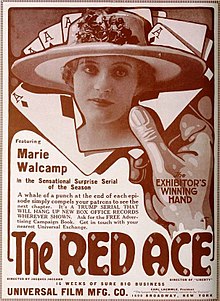Before cowboys ruled the boob tube, a typical western feature invariably began and concluded in one or two hours time, satisfying the theatre-goers’ appetites and sending its heroes and heroines on their way.
An exception to that rule came in the form of an episodic action or suspense serial, which preceded the main feature and was usually shown in twelve weekly installments. The first chapter introduced a setting, the story and its characters. Subsequent chapters presented 15-minute story developments capped by tense climaxes or “cliffhangers” that enticed fans to return to the hosting theatre the following week, regardless of the main feature’s appeal or merits.Like other cliffhanger serials, these westerns often featured sinister or mysterious figures whose identities and motives were to be revealed as the story unraveled twists and turns and presented its subplots with multiple tragedies and victories.
This is part 1 of 15. View them all: Click Here!
The vast duration of these stories allowed for the employment of endless story elements but their economic limitations dictated minimal sets, locations, actors, extras and special effects. Recycled stunt footage courtesy of previously shot productions would invariably be cut into the finished products for further enhancement.
As budgetary considerations were of primary consideration to their producers, westerns became one of the most common serials churned out, owing to their popularity and affordability. Many higher-paid silent-era cowboys lost some box office value in studios’ acquisition of western stars for cliffhangers.
This is part 1 of 12. View them all: Click Here!
After the advent of sound, western serials attained a ‘golden age’ of their own and remained a continual presence until the television age had taken over and replaced the serials’ niche as the 1950s arrived.
While many western serials are thought lost or rarely screened, some have achieved a certain degree of renown and their prints survive intact on video and television releases. Many others were edited down and released in condensed versions as feature westerns to be sold later to exhibitors and networks. In any form, they represent a significant piece of western film lore and an often forgotten example of how exciting and compelling western stories were told and appreciated in their heyday.Nearly all silent western serials are believed to be lost films. The earliest true example was probably 1916’s Liberty, involving a kidnapped heiress played by “Dare-Devil Girl of the Movies” Marie Walcamp.
The Masked Rider (1919) was the first serial to exploit the ‘masked horseman’ concept. Previously believed lost, most chapters currently survive. Incidentally, those episodes feature the earliest surviving film performance of movie legend Boris Karloff.By contrast, Ruth of the Rockies (1920) has only two chapters of its story to have survived. Prior to the highly successful The Indians Are Coming starring Tim McCoy, many thought the introduction of sound would send serials quietly into the sunset. Based on a novel by (the) Buffalo Bill, the first all-talking serial proved them wrong.
The serial boom especially dominated silver screens from the mid-1930s to the mid-Forties, fastidiously producing cliffhangers with the wild exploits of celebrated cowboys like Allan Lane, Buck Jones, Tom Tyler, Tom Mix, Dick Foran, Wild Bill Elliott, Harry Carey, Ken Maynard, Rex Lease, Bob Livingston, Johnny Mack Brown, Lon Chaney Jr. and (let’s not forget) Rin Tin Tin.
Many of the final western serials produced in the early Fifties were Zorro or Lone Ranger cliffhangers (or clones thereof). Curiously, masked men were a particularly hot property at the time. Recycled footage from previous serials was also used extensively in many of those latter-era productions.So go ahead and indulge in the edge-of-your-seat perils of your favorite cowboy hero. Just remember, when he’s facing that oncoming train, avalanche or blast of dynamite, that you needn’t worry- the creative team will find a way out for him. It’s the rule and benchmark, after all, of that great magnum opus of the B-western, the cowboy serial!
About the Author
Western Magazine Digest Senior Editor Christopher Robinson is a writer, filmmaker and musician in New Jersey who has contributed to several magazines and websites.
Robinson also worked as a cameraman, videographer, cable access TV host, teacher and producer. He scripted and produced commercial videos as well as cable television programs for local consumption.
For more info about Christopher, click here.
Be sure to visit THE TV WESTERN AND MOVIE FAN PAGE on Facebook!


















No comments:
Post a Comment
Thank you for your comment.